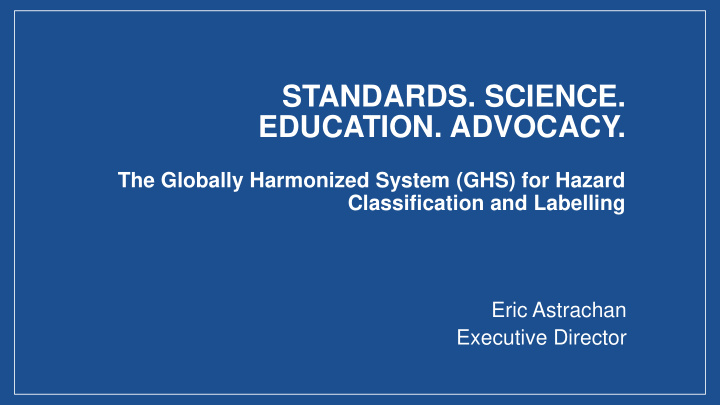



STANDARDS. SCIENCE. EDUCATION. ADVOCACY. The Globally Harmonized System (GHS) for Hazard Classification and Labelling Eric Astrachan Executive Director
GHS: What is it…Or is not? • A common and coherent approach to defining and classifying hazards, and communicating information on labels and safety data sheets based on program developed by the United Nations • Target audiences include workers, consumers, transport workers, and emergency responders. • In the USA, this is not a new Occupational Safety and Health Administration (OSHA) standard • It’s a revision to the existing OSHA Hazard Communications Standard (HAZCOM 2012) based on the United Nations system of labeling & classification of chemicals
GHS – Major Changes • Container Labeling • Classification and hazard identification of chemicals • Safety Data Sheet (SDS), formerly known as Material Safety Data Sheet (MSDS), format and content
GHS – What will not change • Manufacturers will: • Still have to keep chemical inventories • Still have to maintain safety data sheets • Still have to train new people on the potential hazards of what they will be working with • Still have to maintain records for 30 years, per OSHA
Scope of GHS • Covers all hazardous chemical substances, diluting solutions, and mixtures. • What is not covered: Pharmaceuticals, food additives, cosmetics and pesticides (except where workers may be exposed and in transport).
The GHS Elements • Classification Criteria • Health and Environmental Hazards • Physical Hazards • Mixtures • Hazard Communication • Labels • Safety Data Sheets
Safety Data Sheets • These are chemical fact sheets that contain all the information an employee would need to know about a hazardous chemical • Keep current MSDS available until new SDS are received. Archive old MSDS as new SDS are collected. • Each SDS is broken down into 16 universal sections
Safety Data Sheets 1. Identification 9. Physical and Chemical Properties 2. Hazard Identifications 10. Stability and Reactivity 3. Composition / Ingredient Information 11. Toxicological Information 4. First Aid Measures 12. Ecological Information 5. Fire-Fighting Measures 13. Disposal Considerations 6. Accidental Release Measures 14. Transport Information 7. Handling and Storage 15. Regulatory Information 8. Exposure Control/Personal Protection 16. Other Information
Label Requirements • Labels are required to have: • Pictograms • Signal Words • Hazard Statement • Precautionary Statements • Product Identifier • Supplier Identification • Supplemental Information (as required)
Pictograms • Each chemical will have AT LEAST one pictogram • Often multiple pictograms – to visually convey the hazards associated with it
Signal Words “Danger” or “Warning” • Used to emphasize hazard and discriminate between levels of hazard. • If there is no significant hazard, a signal word won’t be used
Hazard Statements • Phrases that describe the nature of a hazard: • Examples: • Highly flammable liquid and vapor • May cause liver and kidney damage • Fatal if swallowed
Precautionary Statements • Recommend measures that should be taken to minimize or prevent adverse effects resulting from exposure to the hazardous chemical: • There are four types of precautionary statements: 1. Prevention (to minimize exposure) 2. Response (in case of accidental spillage or exposure) 3. Storage 4. Disposal
Supplemental Information • The supplier may provide additional instructions, expiration date, fill date or information that it deems helpful. • An example is the personal protective equipment (PPE) pictogram indicating what to wear.
In US, When is Labelling Required • Federal regulations implemented by the Consumer Product Safety Commission (CPSC) and the Occupational Safety and Health Administration (OSHA) require that products containing hazardous materials have warnings on the product label. • Products used by “consumers” are regulated by the CPSC, while products used by workers are regulated by OSHA.
Which Regulatory Body – CPSC or OSHA? • Regulatory jurisdiction depends on the distribution and use of the product. • Three scenarios must be considered: • If the product is distributed to and used exclusively by consumers as a “consumer product”, it is regulated by the CPSC. • If the product is distributed and used exclusively in the workplace, it is regulated by OSHA. • If the product is distributed to and used by both consumers and the workplace, both CPSC and OSHA have jurisdiction. However, consumer products that are used in the workplace are exempted from the label warning requirements of the OSHA regulations.
GHS Compliance Deadlines • December 1, 2013 • Employee training to become familiar with new label elements and safety data sheet format • June 1, 2015 • Manufacturers and distributors are required to have updated container labels on their products • December, 2015 • Distributors may ship products labeled by manufacturers under the old system until 12/1/15 • June 1, 2016 • Replace old MSDS with new SDS
Thank You
Recommend
More recommend